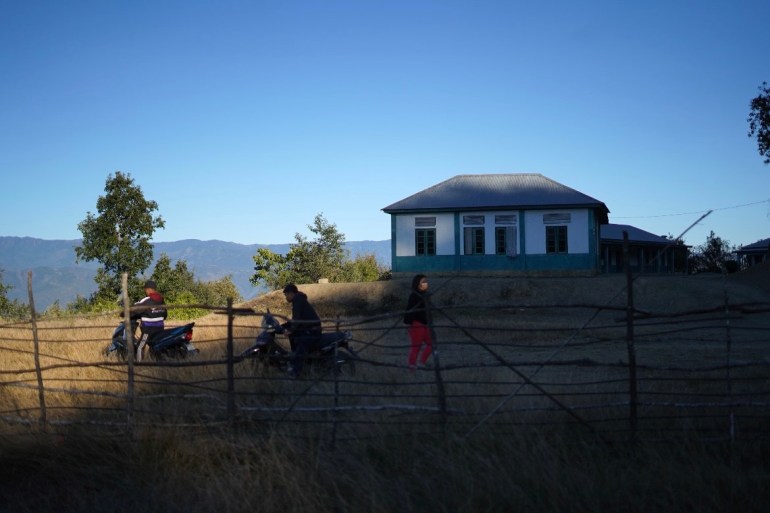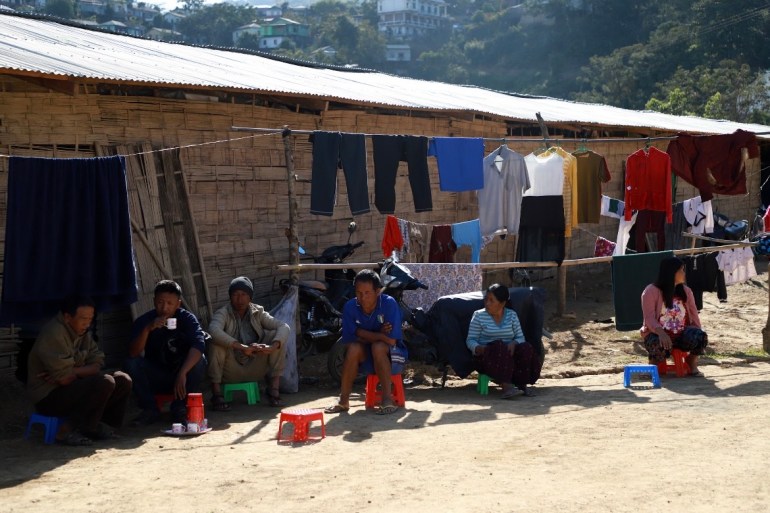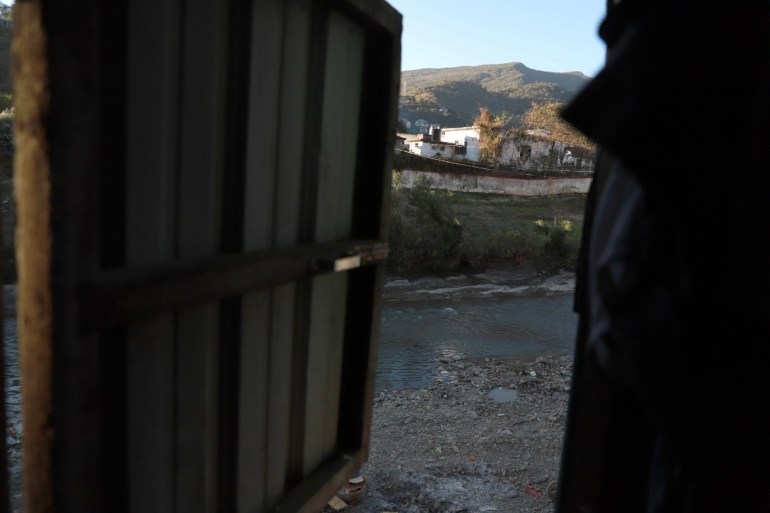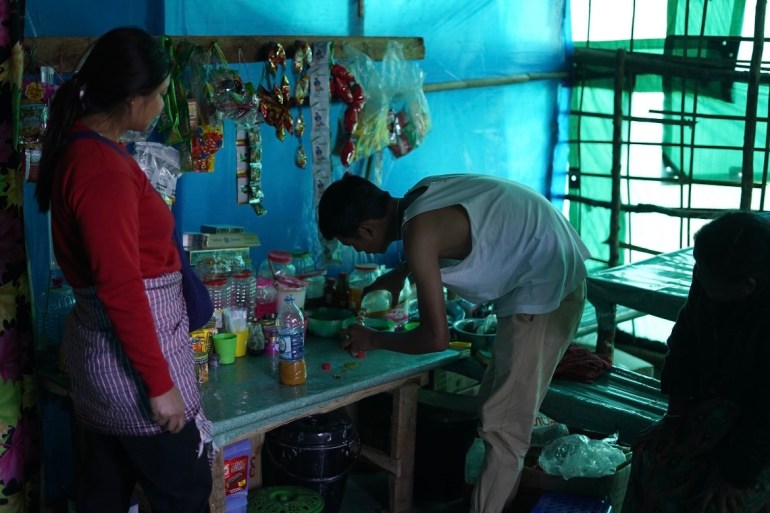[
Zokhawthar, Mizoram, India – The previous few weeks have been full of hysteria for 61-year-old Vanlalchaka.
Nestled on a hill amid lush inexperienced hills within the northeastern Indian border village of Dzokhawthar, Vanlalachka's farm has been a protected haven for refugees fleeing the civil battle in neighboring Myanmar since 2021. 5 refugees at the moment reside there and Vanlalachka is main efforts within the village. , which is positioned on the banks of the Tiau River to assist different folks coming throughout the border.
Like his ancestors, he mentioned, he has by no means accepted the political boundaries that divide his ethnic tribe – often called the Chin in Myanmar, the Mizo within the Indian state of Mizoram and the Kuki within the Indian state of Manipur. Is.
Vanlalachka's spouse BM Thangi is from Chin State of Myanmar. Vanlalachka is thought by one title as is the customized in his neighborhood.
“The folks of Zokhawthar and Khawmawwi (adjoining border villages in Chin State) work as one village,” mentioned Vanlalachka, 59, sitting subsequent to Thangi. When somebody falls in poor health, we cross the border to fulfill sufferers and keep in a single day if crucial.”
This won’t be doable now.
As Mizoram prepares to vote on April 19 within the first of seven phases of India's nationwide elections, its border communities are grappling with deep rifts of their lifestyle.
For hundreds of years, many indigenous communities in India's northeastern states of Mizoram, Nagaland, Manipur and Arunachal Pradesh share the identical ethnicity and reside on either side of the present 1,600 km (1,000-mile) worldwide border between India and Myanmar. In truth, their co-existence as a neighborhood continued even after India and Myanmar gained independence, largely because of the open border.
In 2018, Prime Minister Narendra Modi's Indian authorities went a step additional in its outreach to the nation's north-east and Myanmar's then-democratic authorities: It introduced a free motion regime with Myanmar, permitting folks on either side of the border. Allowed to. Cross 16 km (10 mi) into one other nation with no visa. Folks had been required to have a border allow, legitimate for one 12 months, to remain on the opposite aspect of the border for about two weeks at a time.
However this February, simply weeks earlier than the multi-phase elections had been to start, the Indian authorities canceled the settlement “to make sure inner safety” and “to take care of the demographic construction” of areas bordering Myanmar. Stated Amit Shah, Dwelling Minister of India.
The choice got here amid escalating clashes in Myanmar between varied insurgent teams and the army, which seized energy by means of a coup in 2021. These clashes have sparked a refugee disaster, turning cities like Zokhawthar into protected havens for folks fleeing. However many in India's northeast see a deeper political cause behind the choice to seal the border: Blaming migrants and refugees is a handy escape from addressing the deeper inner safety failures which have led to violence within the area in current months. Is.
Nonetheless, for Vanlalachaka and others in his village, politics are secondary – and the tip of the free motion rule feels private.
“The central authorities’s resolution to erect fencing (on the border) and finish the FMR will separate our households,” Vanlalachka mentioned. His spouse Thangi mentioned, “This can be very unlucky.”

'Why?'
From commerce to farming, the lives of 1000’s of individuals have lengthy relied on open borders: Dzokhawthar's favourite betel nuts and handmade cigarettes are purchased from Myanmar; Beer cans have nation labels; And shifting round in Mizoram's rugged border space is impractical with no Kenbo-125 bike – which additionally comes from Myanmar.
“We primarily rely on border commerce. If the import of commodities important for our livelihood stops, many of the residents of this village should migrate as they’ll turn out to be unemployed,” mentioned Vanlalachaka.
Because the 2021 army coup in Myanmar, Mizoram has hosted 1000’s of refugees fleeing violence, regardless of opposition from the federal Indian authorities, which in September requested the state authorities to gather biometric particulars of Myanmar refugees. The state authorities refused.
About 80,000 refugees and asylum seekers from Myanmar reside in India, 53,000 of them because the 2021 coup. Mizoram alone is dwelling to half of them – 40,000 refugees – settled in makeshift camps in villages like Zokhawthar, in line with 2023 information from UNHCR.
“Like different residents of Mizoram, now we have many shut kinfolk in Myanmar,” Thangi mentioned. Final month, his older sister, Marowi, and her household joined him, flying in from Kalemyo, Myanmar, amid worsening preventing. “His home was bombed this morning,” he mentioned, “we’re fortunate it didn't occur whereas he was at dwelling.”
His eldest sister, Lalchami, 73, fled together with her two kids when the fierce preventing moved nearer to their dwelling in 2022. Now, Lalchami and her kids reside in a makeshift hut manufactured from wooden and tin sheets in Vanlalchaka's farm. Lalchami's 42-year-old daughter, Malsawmsangi, is affected by breast most cancers.
“My daughter's most cancers has now unfold to her lungs. If we keep in Myanmar, it is going to be very troublesome for him to get therapy,” Lalchami advised Al Jazeera. Their nearest medical facility is in Kalemyo, now a battlefield, whereas medical services in Yangon and Mandalay are inaccessible to them.
“What if we return and the preventing begins once more? We’re lucky that she will be able to get medical therapy in Mizoram,” she mentioned. “In our scenario, the try and isolate us (by the Indian authorities) is gloomy and places us in a weak place.”

push and shove
The transfer by the Indian authorities has been opposed not solely by the border communities but additionally by political leaders of the 2 states, together with allies of Modi's Bharatiya Janata Get together (BJP).
Mizoram Dwelling Minister Okay Sapdanga has described the India-Myanmar border as a colonial legacy that promotes ethnic division. In February he mentioned folks had been “dreaming of unification and can’t settle for the India-Myanmar border imposed on us.” Earlier, Sapdanga's occasion, Zoram Folks's Motion, had made it clear that they’d not be part of an alliance led by the BJP or the opposition Congress “to take care of its identification as an unbiased regional occasion free from the management of (New) Delhi”. Won’t shake palms.
In Nagaland, the BJP's ally occasion moved a decision within the state meeting on March 1 arguing that New Delhi's resolution to finish free motion would break age-old ties.
Throughout the border, the Nationwide Unity Authorities (NUG) – Myanmar's government-in-exile comprising lawmakers ousted in a 2021 coup – can be involved in regards to the change in India's coverage.
“Burma is at battle and it’s a resistance battle; “The nation just isn’t in a standard scenario,” a senior NUG International Ministry official mentioned in a cellphone interview on situation of anonymity from an undisclosed location. “And we rely closely on India in asking for humanitarian help as a result of “Our individuals are working to avoid wasting their lives from the junta.”
The official mentioned that NUG has conveyed its considerations to India. “New Delhi wants to just accept that FMR is a humanitarian necessity,” the official mentioned. “A rustic of India's stature shouldn’t impose that form of humanitarian disaster on our folks.”
Constructing border fencing and ending free motion can be dangerous in the long term for New Delhi, which has for many years had a tense relationship with India's north-east – a area that has seen main separatist actions, a few of which have simply are additionally alive.
“Successive governments have realized that native ethnic communities maintain the open border coverage pricey to their social and cultural survival,” mentioned Angshuman Chaudhary, affiliate fellow on the Heart for Coverage Analysis (CPR), a New Delhi-based suppose tank. Myanmar and Northeast India. “For those who tamper with it, you’ll create new cycles of discontent and violence. There are plenty of ethno-political variations, and border fencing is one other entrance to oppose the central authorities.

border insecurity
After all, India has its personal actual safety considerations.
Myanmar's army, the Tatmadaw, has suffered vital setbacks in current months, with the insurgent Arakan Military capturing a number of army posts and making territorial positive factors in western Myanmar.
Michael Kugelman, director of the South Asia Institute at Wilson Worldwide, mentioned the Indian authorities's transfer to erect the border fence is in some ways “a response to the quickly escalating and worsening battle in Myanmar, which poses main border safety considerations for India and Bangladesh.” Is”. Heart, in Washington, DC.
“India needs to make each doable effort to cut back the potential of the battle in Myanmar spilling over into India,” he mentioned.
However managing the border on the floor stage is a posh matter.
When Al Jazeera visited in March, the bridge over the Tiau River connecting Zokhawthar and Khawmawi was being managed by the Indian Military's Assam Rifles, Mizoram Police and rebels linked to Myanmar's Chin Nationwide Protection Pressure (CNDF) .
Rodina, the CNDF secretary, mentioned the world simply reverse Myanmar “is within the palms of the folks”, which – like Wanlalchaka – goes by the identical title.
Whereas the CNDF is attempting to reopen hospitals within the space underneath its management, “we can’t admit critical sufferers because of the lack of medical services”, Rodina mentioned. “Many sufferers will nonetheless must go to Mizoram for medical therapy.” It’s unclear how possible this is likely to be if the border had been fenced.
In the meantime, locals on the Indian aspect say Assam Rifles has elevated the presence of armed personnel because the fencing plan was introduced in February.
And New Delhi finds itself in “uncharted territory,” CPR's Chowdhury mentioned, as a result of within the border state of Chin, the CNDF just isn’t the one main insurgent pressure. And completely different insurgent teams don't all the time agree. At current, India seems to lack a coherent coverage to cope with these a number of teams, he mentioned.

Manipur piece of the puzzle
Nonetheless, some analysts additionally query whether or not India's new coverage place is partly motivated by one other disaster – fully inside India – in Manipur state, north of Mizoram.
Greater than 200 folks have been killed and 1000’s displaced in ethnic violence that broke out in Might 2023 and violence has continued between Manipur's majority Meitei inhabitants and the Kuki and Naga minorities since then. The state BJP authorities has been accused of stoking pressure to strengthen its Meitei assist base – a cost the occasion has denied.
The BJP, in flip, has denied these allegations and blamed “unlawful immigrants” from Myanmar for the violence. However critics say the designation goals to divert consideration from the federal government's inner safety failures.
“For them to level to borders and say immigrants are accountable — that's simply pure distraction,” CPR's Choudhary mentioned.
Chaudhary identified that previously, Indian governments – together with Modi's – have shied away from shifting ahead with border fencing even after lethal assaults on Indian safety personnel by armed fighters from Myanmar.
If it goes forward with fencing this time, the Modi authorities dangers alienating already distant communities and “inflaming a cycle of discontent and violence,” Chaudhary mentioned.
“Ultimately it's all going to go fallacious. and for what?”

